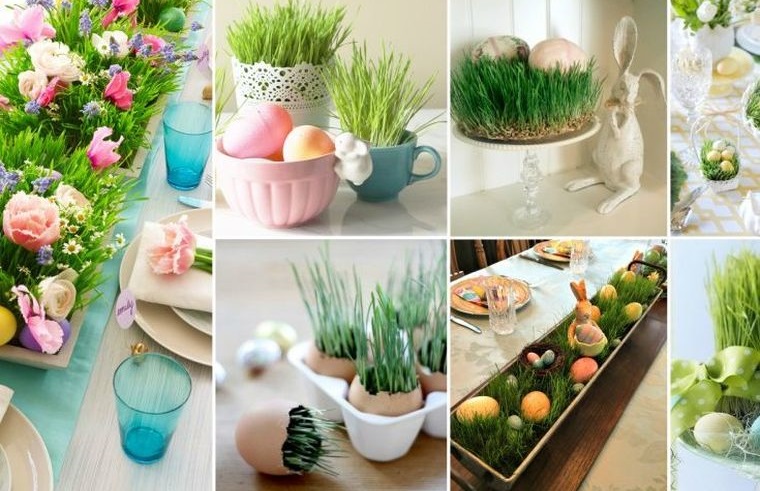
Wheatgrass certainly makes a very attractive plant when used for decoration. But in addition to having a beautiful bright green color and being perfect to decorate in spring. It also provides many benefits that are based on evidence. But do not worry, in this article, in addition to showing you beautiful ideas to inspire you in your decoration, we will also help you so that you can grow and take advantage of all the benefits of wheatgrass. Of course, to start with, you can buy grass in small packages or flat in health food stores, ready to be turned into decoration. Or you can grow it yourself from durum wheat berries, which you can also get at health food stores. As with other plants, wheatgrass also requires water and sunlight to grow.
Wheatgrass Decorating Ideas
You can certainly create a porch planter or planter out of wheatgrass instead of using flowering plants. You should only fill the bottom of a rectangular pot or window box with a variety of rocks or pebbles for drainage. Then add a layer of potting soil, filling in everything but about the top two inches. Lay the growing wheatgrass, including the roots, on top of the prepared soil. Fill the pot and lastly, water until the soil is moist.

If you are using sprouted wheatgrass that is not yet tall, then cover the entire surface of the soil with wheat sprouts so that there is enough to create a lush, grassy display. Add a thin layer of potting soil and then water. Of course, this pot can be used to decorate a fireplace mantel, a bookcase or on a wide window sill indoors. Now, try placing a shallow layer of pebbles in the bottom of three or four cups of tea, which you obviously don’t use.

Add a two-and-a-half-centimeter layer of potting soil over the pebbles placed in the cups, then place the rooted wheatgrass in each cup that looks full. If you are using young shoots, then sprinkle a small layer of soil on top of the shoots in the cups and a little water. Then place the cups in a sunny spot until the grass grows. You can place the herb cups in saucers on a dining table or in the kitchen or if you wish you can also place them on a small table in your patio or garden.

Wheatgrass Brings Freshness and Color to Decor
Wheatgrass decorations make any room look really cool. Especially in the spring, adding green grasses will make you feel closer to nature. Certainly there are great ideas to place this beautiful and beneficial grass either in a bucket, flowerpot, in a bowl, teacups, glasses, wooden boxes and much more, to decorate both the interior and the exterior of your home. In the same way you can use wheatgrass for decorations for birthdays, weddings and other events.

You can also make a growing wheatgrass decoration by filling different wine glasses, shallow mason jars, and bowls for a quick, temporary, soilless tabletop display or centerpiece. You just need to add a little water to keep the roots moist. You can also add some glass gems to give it an additional decorative touch. Place a transparent plastic tray and in the center place a vase full of flowers or twigs. Then surround the vase with wheatgrass plugs, thus creating a complete display on the tray.

Grow wheatgrass yourself for your home decoration
Well, after you have bought your durum wheat berries, you should soak the wheat in water for at least 12 hours. You should have some rocks or pebbles on hand for drainage. And of course the container where you are going to grow your wheatgrass. Place a layer of rocks in each container. Add some potting soil over the rock layer. Then add a layer of wheat. Keep in mind that if you don’t add enough, the wheatgrass will be thin and sparse.

So it is better to add a lot of wheat and you will be very happy with the result. Then cover very lightly with a thin layer of potting soil. Water the top of the soil very well and then wait for the wheat to sprout. Remember that your crop should receive a lot of sunlight and water, but not too much. You can cover them with plastic to produce a greenhouse effect. This is in the hope that they will sprout faster although it is not mandatory.

Trimming Your Wheatgrass
If you wish, you can give them a trimming so that the top of the grass is even. Of course it is your decision. Many people like to trim wheatgrass to make it even. But there are also many people who prefer to leave their grass as they grow. If you want, you can place your wheatgrass in a basket or in any container or pots. With wheat grass you can make various decorations for any room in your home including your terrace. Wheatgrass is actually a simple decoration. But certainly inexpensive and cool to welcome warmer weather.

Evidence-Based Benefits of Wheatgrass
Wheatgrass is the newest ingredient to enter the world of natural health. This is prepared from the newly germinated leaves of the common wheat plant. As we already mentioned, it can be grown and prepared at home. Or you can also buy it in juice, powder, or supplement form. Here are some of the evidence-based benefits of drinking wheatgrass. However, we recommend that you go to your trusted doctor if you want to add wheatgrass to your diet.

High in Nutrients and Antioxidants
Wheatgrass is an excellent source of various vitamins and minerals. It is especially rich in vitamins A, C and E. As well as in iron, magnesium, calcium and 17 amino acids of which eight are essential. Remember that our body does not produce amino acids. So we must obtain them from food sources. Like all green plants, wheatgrass also has chlorophyll. Which is a type of plant pigment associated with many health benefits. It also has several important antioxidants, including glutathione and vitamins C and E.

It should be mentioned that antioxidants are compounds that fight free radicals. In order to prevent cell damage and reduce oxidative stress. Some studies have suggested that antioxidants can help protect against certain conditions. Such as heart disease, cancer, arthritis, and neurodegenerative diseases. In a study conducted with rabbits fed a high-fat diet, wheatgrass decreased oxidative stress. And it improved the cholesterol levels in them. Of course, the research and studies carried out have so far been limited to test tubes and animals. So more studies are needed to determine how its antioxidants can affect people.

May Relieve Inflammation
Inflammation is a normal response, triggered by the immune system to protect the body against injury and infection. Some research shows that wheatgrass and its components can help reduce inflammation. A small study of 23 people looked at the effects of wheatgrass juice on ulcerative colitis. This is a disease characterized by inflammation in the large intestine. Drinking 100 ml of wheatgrass juice for a month, reduced the severity of the disease and rectal bleeding in ulcerative colitis patients.

Remember that wheatgrass is also rich in chlorophyll. Which is a plant pigment with powerful anti-inflammatory properties. A test-tube study showed that chlorophyll inhibits the activity of a specific protein that triggers inflammation. Likewise, it should be mentioned that most of the research has focused on certain compounds in wheatgrass or the effects of wheatgrass on a particular condition. So more studies are needed to measure its possible anti-inflammatory effects in the general population.

May Help Regulate Blood Sugar
High blood sugar can cause a wide range of symptoms. Including headaches, thirst, frequent urination, and fatigue. Also, over time, high blood sugar levels can have serious consequences. Such as nerve damage, skin infections, and vision problems. Some animal studies have found that wheatgrass can help keep blood sugar levels in check. In one study, diabetic rats were given wheatgrass.

Which changed the levels of certain enzymes that help lower blood sugar levels. Another study with diabetic rats treated with wheatgrass extract for 30 days, resulted in a significant decrease in blood sugar levels. But keep in mind that the studies have been carried out in animals. So more studies are needed to understand how it can affect blood sugar in people.

May Help Promote Weight Loss
Many people have started adding wheatgrass juice to their daily diet as a quick and convenient way to accelerate weight loss. By itself, there is no evidence that wheatgrass itself can enhance weight loss. However, various studies have found that thylakoid supplementation could improve satiety and increase weight loss. Wheatgrass contains thylakoids. Which are small compartments found in plants that contain chlorophyll and absorb sunlight for photosynthesis.

Well, in a small study, supplementing a carbohydrate-rich meal with thylakoids was found to enhance feelings of fullness, compared to a placebo. A study in rats showed that thylakoid supplementation increased satiety by slowing stomach emptying and increasing the release of hormones that decrease hunger. Likewise, in another study it was found that, administering thylakoids to rats with a high-fat diet, resulted in a decrease in food intake and body weight, compared to a control group. But there is no research on the effects of wheatgrass on weight loss in people. Although, thylakoids can also be found in many other food sources. This includes greens and leafy greens like spinach, kale, and lettuce.

Wheatgrass gives a beautiful green color for a simple decoration

You can grow this beautiful grass to decorate very easily

Wheatgrass can be used in the decoration of any room in your home

You can achieve a simple but elegant decoration at the same time

It is perfect for decorating a table and enjoying a delicious dinner

Add a subtle hint of color to welcome spring

You can also decorate your exterior with this beautiful herb

Simple but creative centerpiece with flower pots in rainbow colors





